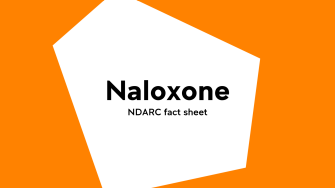3 Jun 2025
NDARC fact sheet:
Naloxone
Naloxone

Naloxone is an opioid antagonist that is a safe and effective agent for reversing the effects of pharmaceutical opioids (e.g., methadone, codeine, fentanyl and morphine) and illicit opioids (e.g., heroin and nitazenes).
Naloxone is often administered by medical personnel, including paramedics, in the event of an opioid overdose. It is also available as an intramuscular injection or intranasal spray formulation that can be purchased at pharmacies in Australia and administered to someone experiencing an opioid overdose.
The brain has many receptors for opioids. An overdose occurs when a person consumes too much of an opioid, meaning that the opioid binds to too many of these receptors. As a result, their breathing may drastically slow down and even stop.
Naloxone lodges in opioid receptors in the brain but does not give an opioid effect. It temporarily ‘clears’ the opioid receptors, overriding the effects of any opioids that have been taken and reversing their effects.This allows a person who has overdosed to breathe again.
In responding to a suspected overdose, people should:
Naloxone is effective in the reversal of nitazene toxicity, and multiple doses may be necessary.
Naloxone was traditionally administered by emergency personnel. Now, anyone who witnesses an overdose can administer naloxone with minimal training. There is strong evidence to suggest that naloxone can be used safely by people who are not medical professionals.
Naloxone is available from pharmacies, alcohol and other drug treatment centres, needle and syringe programs, and custodial release programs. Take-home naloxone training programs are also available and operate from many services that provide care for people who use drugs.
Naloxone has been shown to be a safe drug. It has no effects other than reversing overdose and does not produce intoxication, nor is there a risk of developing dependence.
It is important to note that a person with opioid dependence could experience withdrawal symptoms (e.g., nausea, vomiting, and sweating) when given naloxone to reverse an overdose.
Naloxone stays in the body for a short period of time (between one to two hours), whereas opioids stay in the body for many hours; hence, a person could be at risk of another overdose if they consume more opioids after receiving naloxone.
The Illicit Drug Reporting System (IDRS) is an Australian monitoring system run by the National Drug and Alcohol Research Centre (NDARC) at UNSW Sydney that identifies emerging trends of local and national concern in illicit drug markets.
The Ecstasy and Related Drugs Reporting System (EDRS) is an Australian monitoring system run by NDARC that identifies emerging trends of local and national interest in ecstasy and related drug use, markets and harms.
The Pocket Guide to Drugs and Health is a publication authored by experts from NDARC that provides information for health professionals on the impact of drug use.
The Australian Institute of Health and Welfare collects information on alcohol and tobacco consumption, and illicit drug use among the general population in Australia.
The Australian Bureau of Statistics is Australia’s national statistical agency, providing official statistics on a range of economic, social, population and environmental matters of importance to Australia.
Department of Health and Aged Care (2023). Where to access naloxone. Australian Government. Retrieved from: health.gov.au/our-work/take-home-naloxone-program/where-to-access-naloxone
National Centre for Clinical Research for Emerging Drugs (2024). Emerging drug briefing: nitazenes. Retrieved from: nccred.org.au/resources/emerging-drug-briefings-nitazenes
If you, or someone around you, is experiencing undesired or distressing psychological or physical symptoms from the intake of alcohol or other drugs, please seek immediate medical attention.
If you need urgent help from ambulance services, call Triple Zero (000). If a person has been mixing drugs with alcohol or other drugs, tell the paramedic exactly what has been taken.
For free and confidential advice about alcohol and other drugs, call the National Alcohol and Other Drug Hotline on 1800 250 015. The hotline will automatically direct you to the Alcohol and Drug Information Service in your state or territory.
3 Jun 2025
Fact Sheets
NDARC
Download this resource